Sex determination.
| On presence of epiandrous glands of males |
On cast skin (exuvium) |
| "Complex" method of determination of sex from earlier stages | Sexual dimorphism |
On size and shape of chelicerae
One of the most important moments in accordance with successful breeding of tarantulas in captivity is concluded in possibility as earlier as possible to determine a tarantula sex, to slow down or greatly accelerate tarantulas growing and coming of the sexual maturity.
Last studies of scientists (Rick West, Mark R. Hart), which based on the work of B.J. Marpls "The Spinnerets and Epiandrous Glands of Spiders", 1967, give the only really possible way of exact determination of sex on alive tarantula specimen. As was it already mentionned during the consideration of anatomy of tarantula spinnerets (silken apparatus) the only males has special silken glands (epiandrous glands), apurtenance of which are hardly noticeably openned with minute spinnerets in area of epyginum, anteriorly of the epigastric furrow. These minute spinnerets are situated in 2-4 rows and have semicircular or triangular form. Area of their placed is possible to find due to more shorter and darker specialized setae, disposed as a patch in the manner of “arch” (see picture).
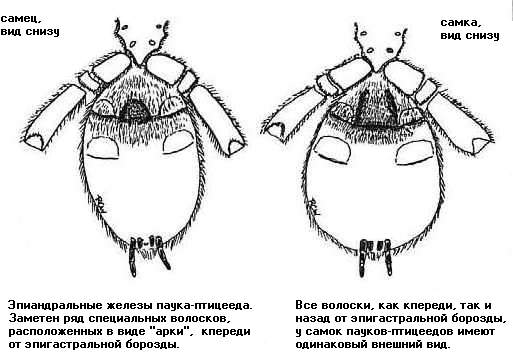
These micro spinnerets similarly to the main tarantula spinnerets calls epiandrouse fusillae and considering to used by male during sperm-webbing. So if they are discovered in specimen it means that it is a male, if not – female. However mastering by this method is requires certain practice and it is necessary to have “piled up eye”, that comes with an experience. Particularly in a complicated way can be to define sex beside species, having brighten colouration of the bottom - Aphonopelma seemanni, Nhandu coloratovillosus, Megaphobema robustum and also such tarantulas as Avicularia spp, Heteroscodra maculata or Stromatopelma calceatum, some others. It is also requires neatness and careful treatment of tarantula specimens. But this method is unique and effective, since it is based on scientific approach and allows safely to determine the sex of alive tarantula specimen.
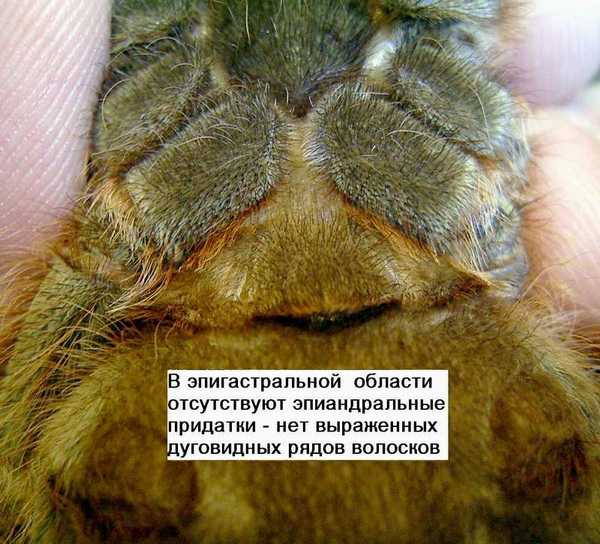 |
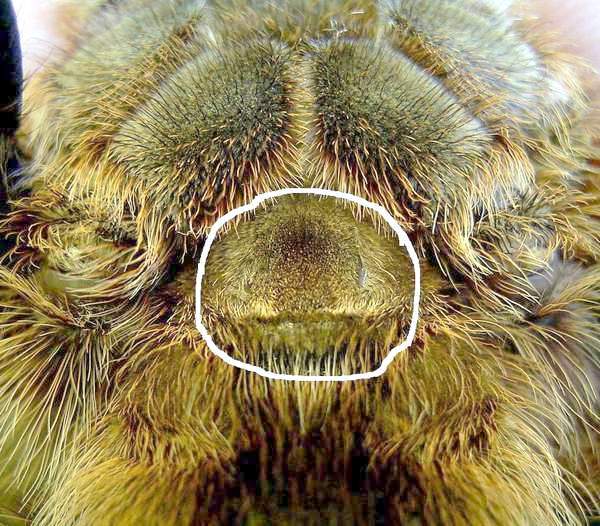 |
This method allows to define sex even beside spiders of early ages, but it is also needs a good additional illumination and binocular or microscope.
Try also the following...
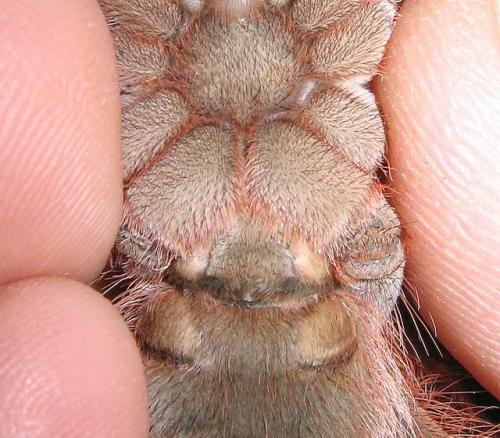 |
Megaphobema robustum pair: |
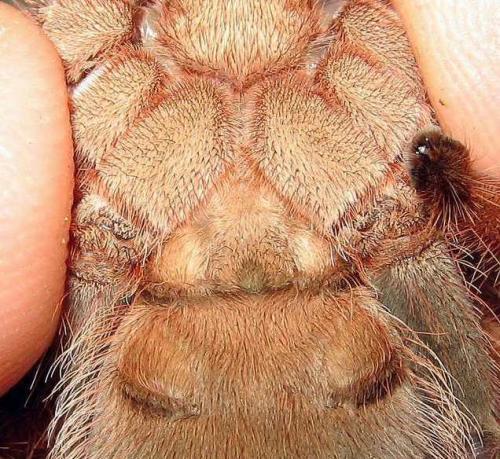 |
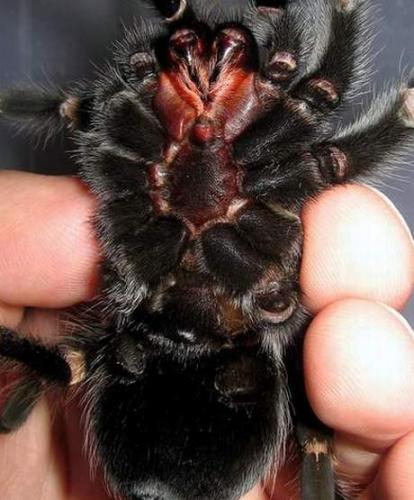 |
Brachypelma auratum pair |
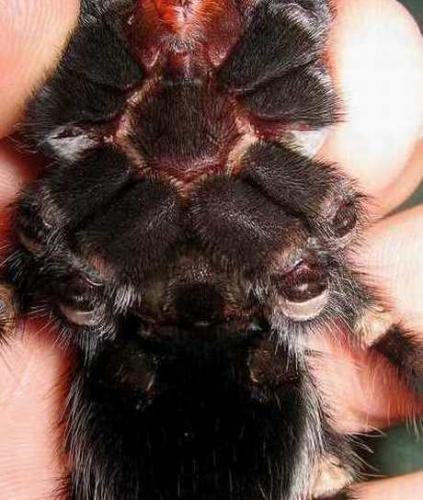 |
The next, also absolutely reliable and exact way of determination of tarantula sex is concluded in study of tarantula exuvium (cast skin), which remaining after its moltings.
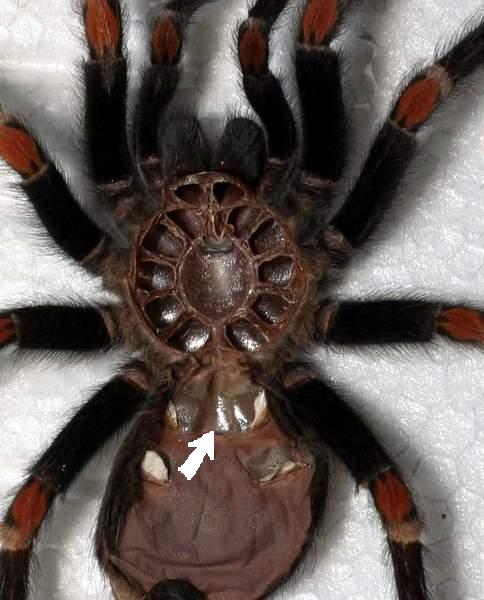 |
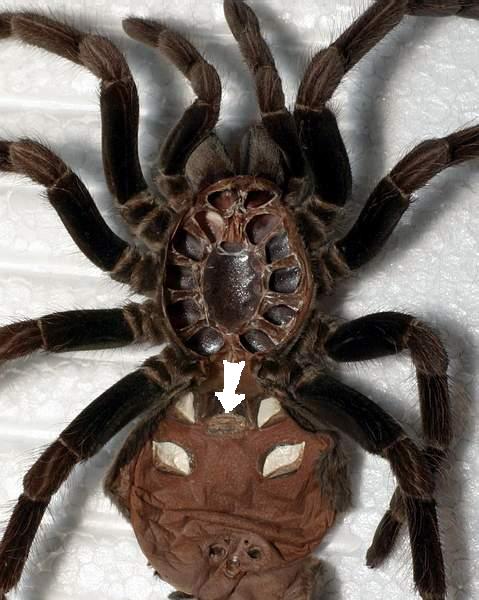 |
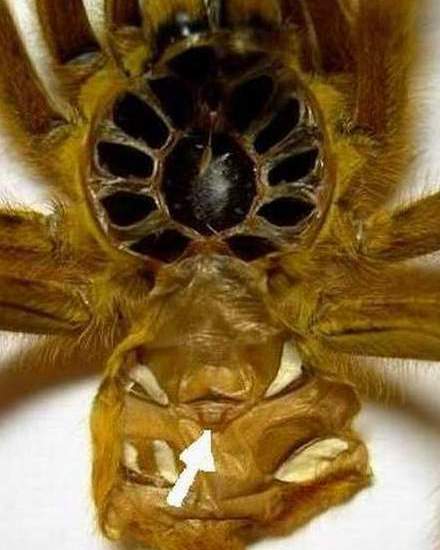 |
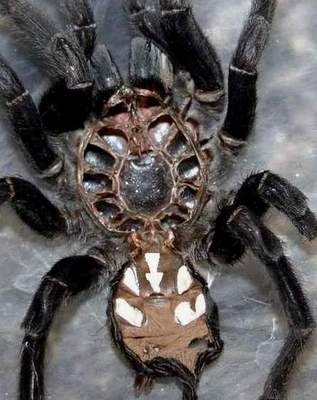 |
For this is necessary to straighten tarantula exuvium as shown in drawings and call attention to the area between the first and second pairs of white spots disposed in base of abdomen. These spots define the place of location of tarantula booklungs – first and the second pairs accordingly. Sexual organs of tarantulas inheres in this area, and female`s exuvium has a trace of spermathecae (seminal acceptor), which is most well denominated beside adult females. Beside males this place has straight (equal) edge.
The good illumination and strong increase are necessary to determine the sex of small specimens of tarantula. But this is rather also difficult because, as a rule, the spermathecae of juvenil specimens of tarantula weakly presented and forms usually at 6-7 molt (Galiano, 1984 and Stradling, 1978). Among different species a form of spermathecae has rather diverse shape.
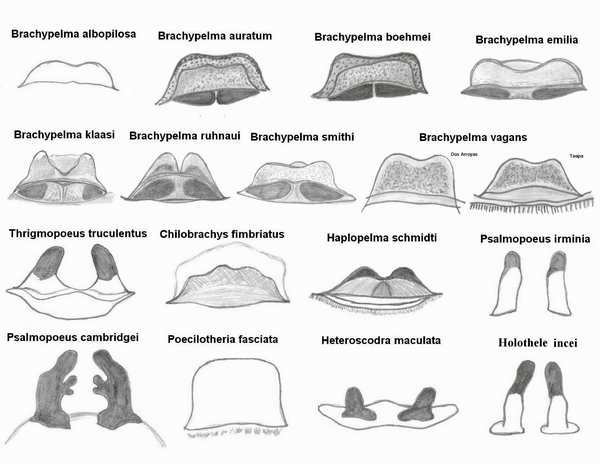 |
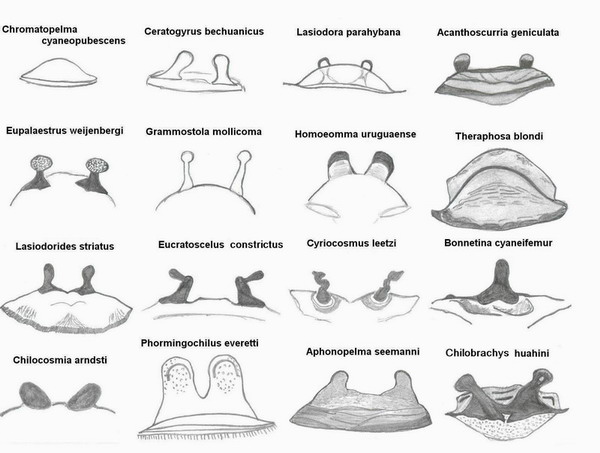 |
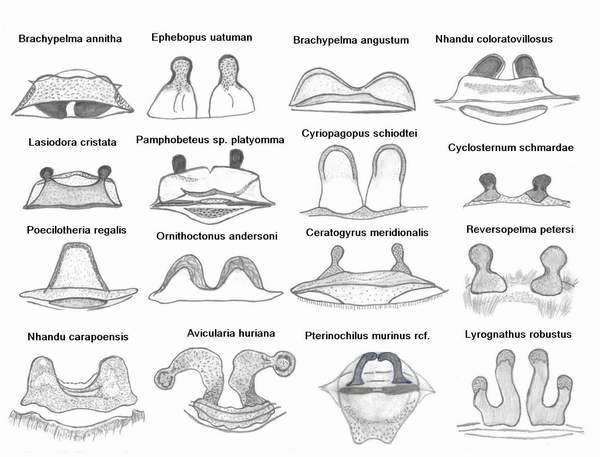 |
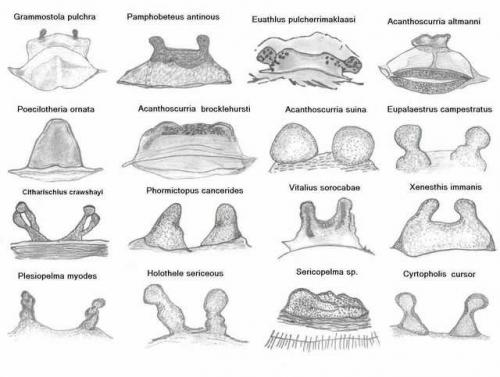 |
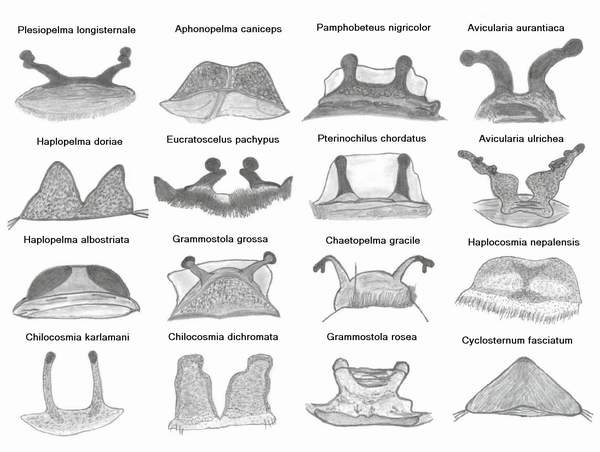 |
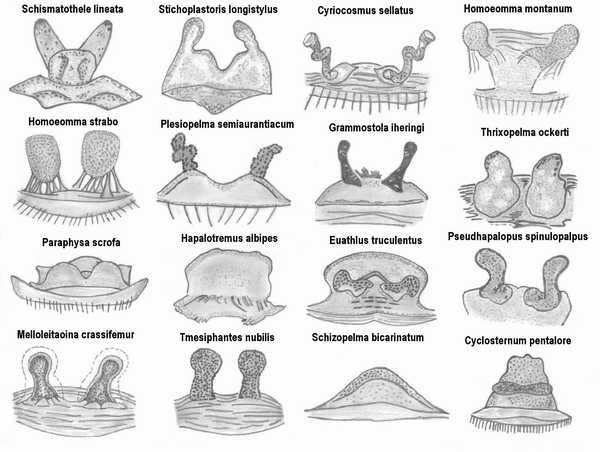 |
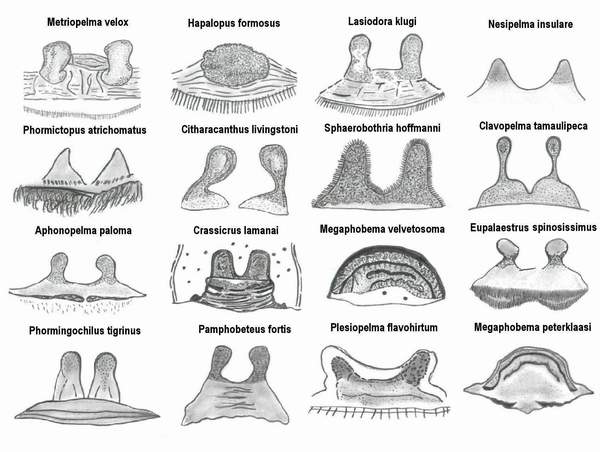 |
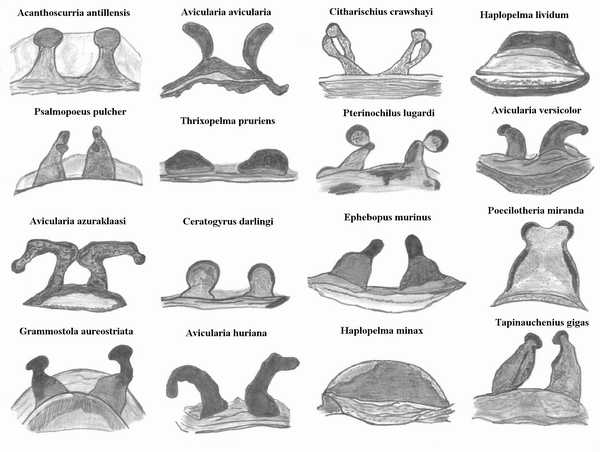 |
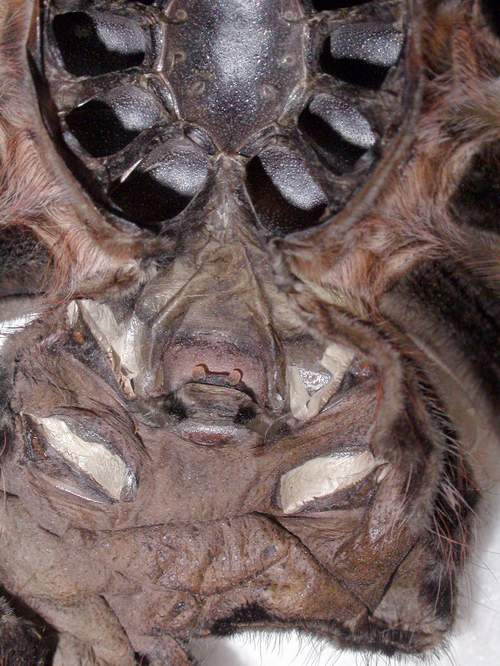
Also it is necessary to take into account that many tarantulas at the short time right after molting has "chew" the exuvium, than bring its in condition, unfit for determination of sex. So, in order to avoid this, is necessary to take the exuvuim right after the molt herewith, in no event having disturbed the spider itself.
The very professional and more detailed guide how to use this the most valid sexing method in theraphosids, including aspect of how to determinate sex among the species of the theraphosids which females lack the spermathecae, authored by British great arachnoculturalist Chris Sainsburry You can find .
At the last time has got also spreading one more "complex" method of determination of sex of alive spiders, allowing with certain share of probability to define attribute of spiderling to male or female accordingly - on form of epigastric furrow, distance between front pair of booklungs and corner of slopping of anterior pair of booklungs.
Lets look at the table below: red marking is specified epigastric furrow, green - line, made through medium of booklung to conditional medium of body of spider (we are interesting in angle formed this line to horizontal line).
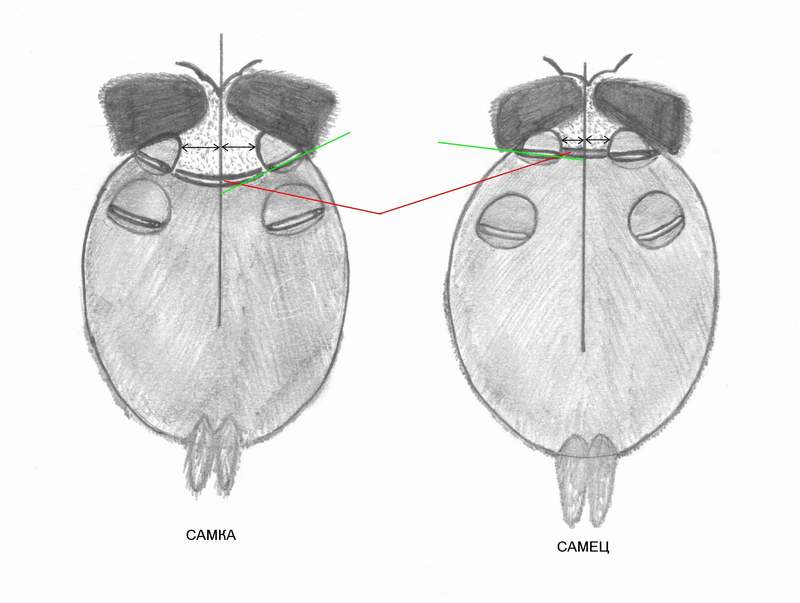
In table are systematized signs and their features for male and females.
| sign | female | male |
| Form of epigastric furrow | more curved in contrast with male | practically presents itself direct line, going between internal corners of booklungs |
| Distance between anterior pair of booklungs | wider apart one from another | closer located to one another in contrast with female |
| Angle formed lower edge of booklung to medium line of body of tarantula | booklungs more detour from horizontal line than at males, angle would be not less 20 degrees | booklungs are situated more horizontally than in males, angle would be nearly 5 degrees |
From this can be seen that with some validity is possible to define the sex of spider, only having possibility of choice from several specimens for comparison. Together with that with account that nobody does not gives You the exuvium for determination when buying a tarantula, this method can although somehow helps You in choice of specimen of desired sex.
One more method (less reliable, at my sight) of determination of sex of tarantulas is concluded in the difference of relative size and shape of chelicerae ("Sexing tarantulas revisited" by Dr. Robert Gale Breene III) the male and female.
Chelicerae of female massive, broader and more robust, than beside males. Chelicerae of male more broad and fine. Male chelicerae are thinner and less broad. Female chelicerae tend to be more bulbous, or swollen; male chelicerae appear slimmer and uniform.
Getting the hang of sexing immatures this way may take a lot of experience raising larger immatures, but it can work. Dr. Robert Gale Breene III itself have had success using of this method with immature Aphonopelma and Brachypelma species. Also he consider that it may be appropriate for more genera.
Regarding commentary to described method (as well as to determination on speed of growing, proportions of body, mentioned above "complex" method and similar methods, which are sometimes meeting in hobby) can only say that it is appraisal and, in my opinion, consideration its as aplying and allowing to really render a help in determination of tarantula sex, not introduces, at least, practical.
It is possible to admit that it can have some practical profit in the aggregate with others.
In different sources is described also some other ways of determination of sex: correlation of abdomen and thorax, correlations of proportions of length of legs to body etc. But all of these, regrettably, are not although any reliable, and so will not be cited here.
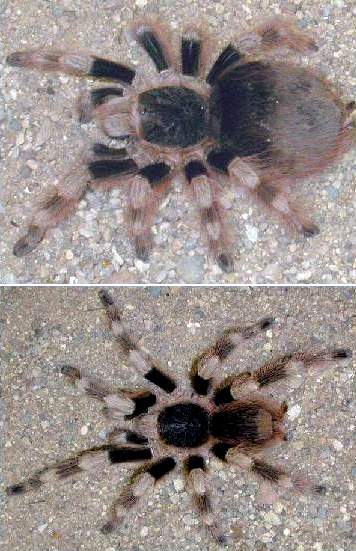 Follows also to say several words about sexual dimorphism beside tarantulas. This is because of beside majorities of tarantulas, as terrestrals, so and arboreals, specimens of different sexes in last age (mature specimens) differ between itself on colouration, form, as well as sizes and proportions of body (mainly correlation of length of legs).
Follows also to say several words about sexual dimorphism beside tarantulas. This is because of beside majorities of tarantulas, as terrestrals, so and arboreals, specimens of different sexes in last age (mature specimens) differ between itself on colouration, form, as well as sizes and proportions of body (mainly correlation of length of legs).
It is necessary however to note that beside separate species this difference becomes noted already at earlier ages (Poecilotheria, Ephebopus, Cyriopagopus), but beside others, as, for instance, submitted at photo on the left mature male and female of tarantula Nhandu coloratovillosus the differences practically minimum.
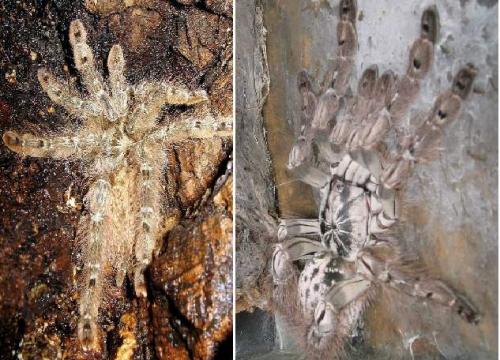
Also at choice it is possible supposedly to define the sex of young tarantulas considering rates of their growing: in relative majority of events males overtake in its growing and development of females of the same age, they grow quicker and so, as a rule, larger them in size.